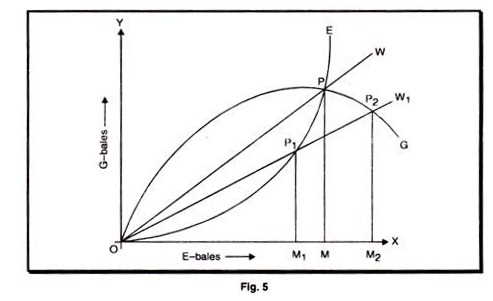Mill’s theory of reciprocal demand has been graphically portrayed by Edgeworth and then by Marshall with so-called “offer curves”.
An offer curve is also called as the “reciprocal demand curve” or international demand curve. An offer curve shows how the volumes traded change when the terms of change.
Thus, offer curve is the locus of the pair of export and import quantities desired at each possible price-ratio.
Suppose, there are two countries England and Germany and there are two commodities E-bales and G-bales. England specializes in the production of E-bales and exports E-bales to Germany in exchange for G-bales produced by Germany.
ADVERTISEMENTS:
In figure 5, we measure along the X axis the number of E-bales supplied by England and along the Y axis the corresponding demand of England for G-bales, thus obtaining the curve OE the supply demand curve of England. The curve OG1 the demand curves of Germany.
The point P1, shows the P1M1 G-bales can be exchanged in England against OM1 of E-bales. The exchange ratio is P1M1/OM1, shown by the slope of the straight line OW, relatively to the X axis. But at this exchange ratio ON2 E-bales will be sold in Germany. This means that the demand of Germany for E-bales is greater than England’s supply. Germany’s balance of payments will become un-favourable; the monetary mechanism will push prices and wages down in Germany and up in England. England will be induced thereby to take more G- bales. Sooner or later an equilibrium will reached at the point P, at which the demand and supply of England equals the supply and demand of Germany.
Thus, according to the theory of reciprocal demand, the international ratio of exchange between E-bales and G-bales is that ratio at which the supply of E-bales by England is equal to the demand for E-bales by Germany and supply of G-bales by Germany is equal to the demand for E-bales by Germany and supply of G-bales by Germany is equal to the demand for G-bales by England; and at this exchange ratio neither Germany nor England have disequilibria in their respective balances of payments.
ADVERTISEMENTS:
Ricardo neglected the role of demand. Mill introduced demand. Marshall and Edgeworth extended this demand analysis still further, particularly through the analytical device of reciprocal demand and supply curves. This approach made possible a general equilibrium solution to international trade a solution in which prices and quantities in production and consumption were counted for.
This is in contrast to the earlier partial equilibrium approach which dealt only with supply conditions. The improved approach used Marshall-Edgeworth offer curves, representing the loci of possible points of trade equilibrium under the assumption that domestic adjustment has been made for each trading position given on the offer curve.
